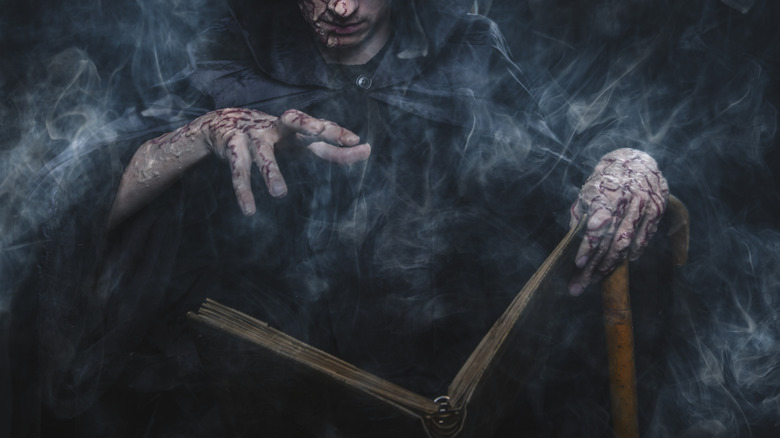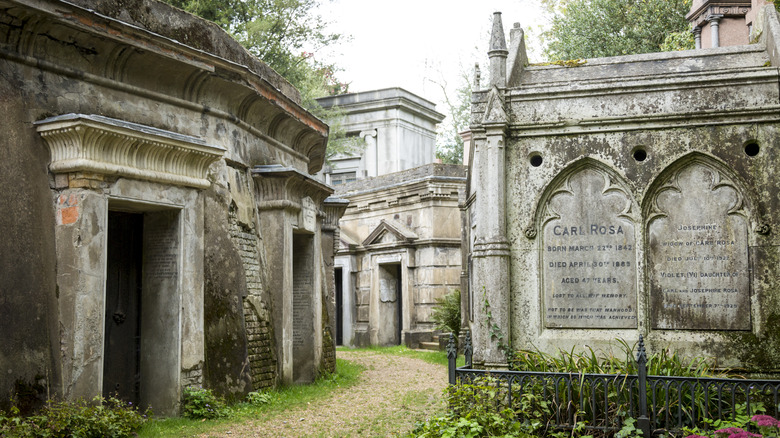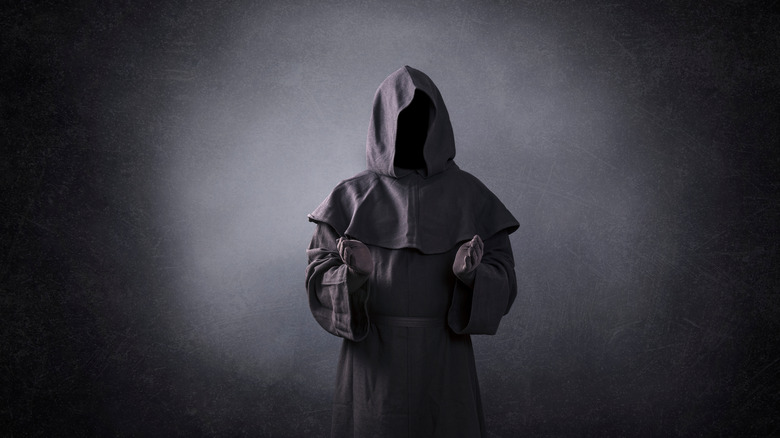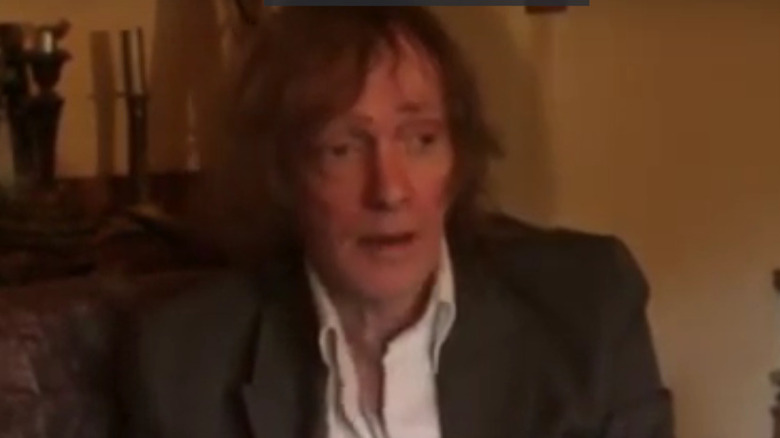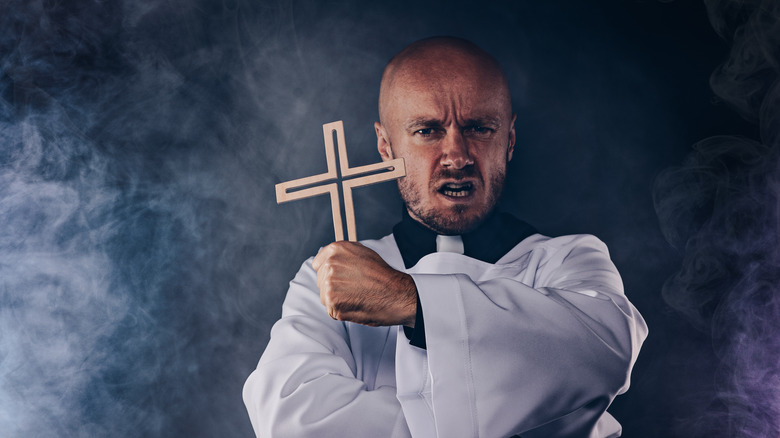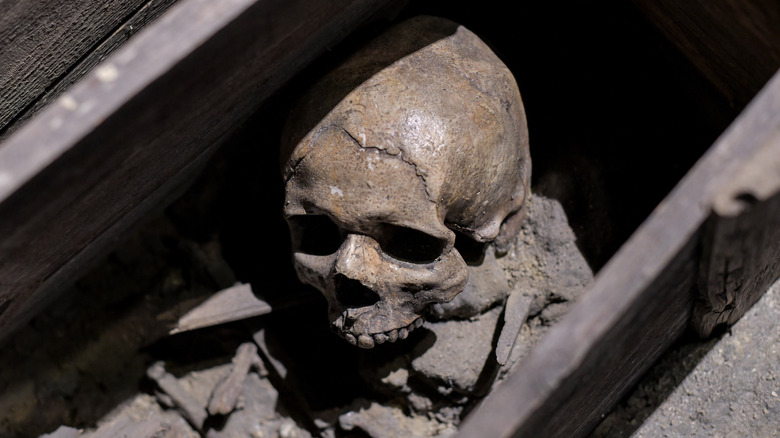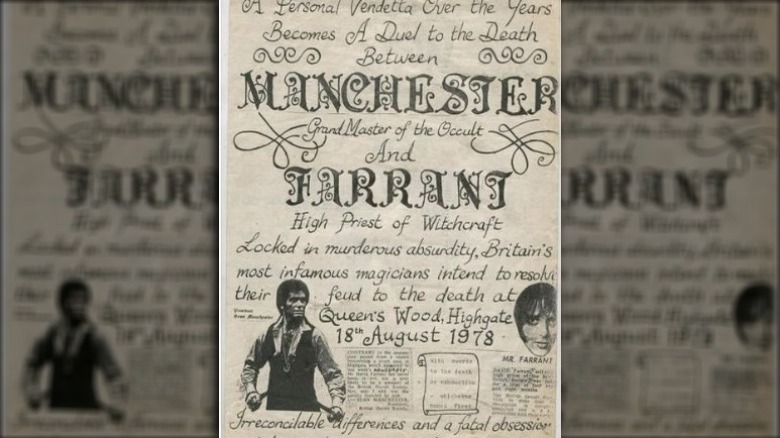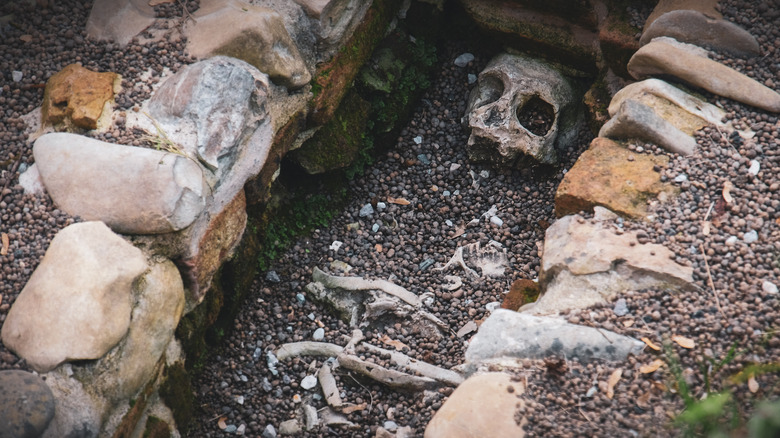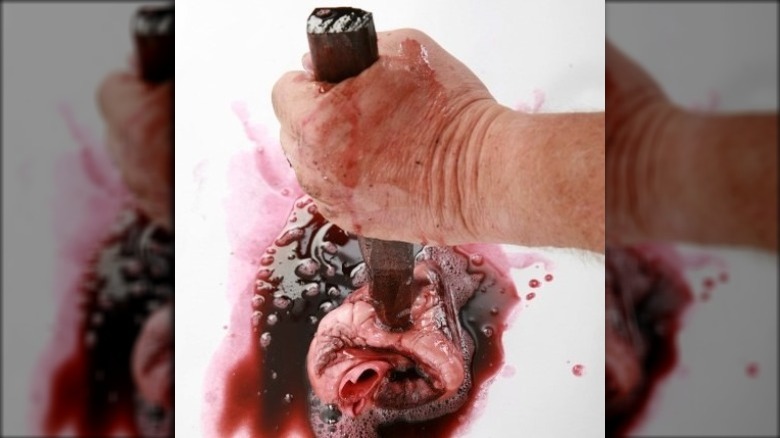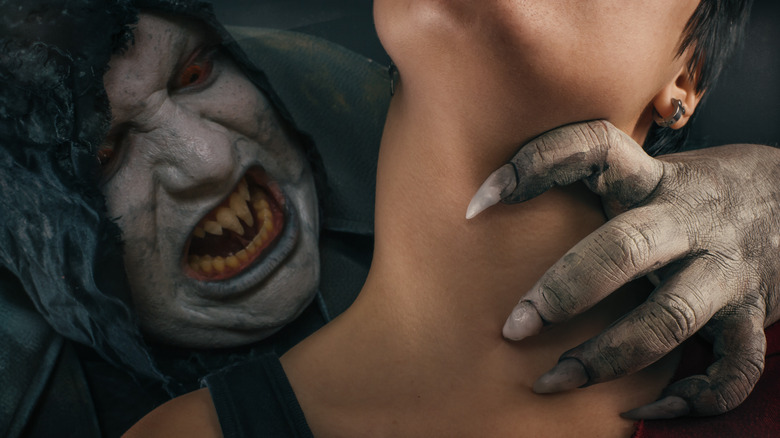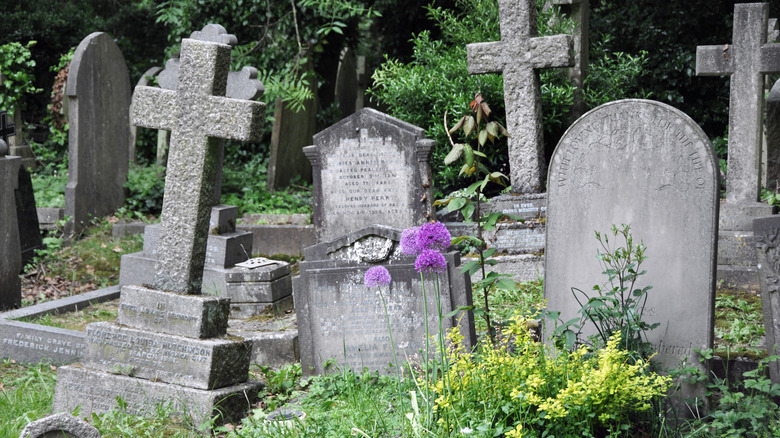The Bizarre True Story Of The Highgate Vampire Feud
In the 1970s, two men, both claiming to wield magic, set out to destroy a supposed vampire stalking a 100-year-old cemetery in London. What could have been fodder for a mediocre horror movie was instead decades of sniping between two men whose hobby seemed to be letters to the newspapers to show whose stake was the longest.
Their feud ended up involving a giant demonic spider, ghostly cyclists, felonies, and much literary squabbling and ended only upon one of their deaths. With both men's quarrels and claims, it is a struggle to deduce where the truth lies with them, but it is a meandering trip to take.
It does, however, seem to involve actually killing a vampire.
Highgate Cemetery
In the 1800s, anyone who was anyone was dying to get into Highgate Cemetery in London, England, according to MyLondon. Initially designed by architect Stephen Geary, it is the final resting place of such luminaries as Karl Marx and George Eliot, and — more recently — Douglas Adams. Kentish Towner reports that among its 170,000 corpses is the lead coffin of Alexander Litvinenko, allegedly assassinated with a dose of polonium. It is a cemetery, in short, rife for an extravagant story.
In addition to the beautiful, vast landscape, the cemetery featured tombstones so ornate that it was as though the dead were trying to show one another up. However, after World War II, it fell into significant disrepair. By the 1960s, the cemetery had fallen into such a state of dilapidation that it was the setting for multiple horror movies, such as "From Beyond the Grave" and "Taste the Blood of Dracula." It was almost too perfect a setting to cause wizards to bicker with one another about the proper way to kill a vampire.
Vice tells the sidenote that Highgate Cemetery also plays host to the ghost of a chicken that Francis Bacon had tried to freeze, which resulted in fatal pneumonia in 1626.
The Vampire of Highgate
In the late 1960s, people began telling stories of seeing a dark figure with blood-red or glowing eyes gliding through the cemetery. In some, he wore a hat (accessories are essential to vampires). MyLondon notes that these tales rapidly found their way into local newspapers.
According to National Geographic, vampire panics were hardly a new phenomenon on either side of the Atlantic, but they tapered off into the 20th century as people became more scientifically minded and less superstitious. However, the people who were going out hunting the vampire — beyond this story's arguable main characters — were not those who suspected that an undead ghoul was draining the lifeblood of their countrymen owing to an ancient curse. Instead, they were engaging in "legend tripping," an elevated game of pretend where someone acts out a spooky story. Usually, this was a harmless matter of trying to spend the night in a haunted house. However, if some graves have to be violated in the process, well, you can't make an omelet without committing a felony.
If there ever was a vampire of any stripe, it was likely just a teenager screwing around in a cemetery to troll people. For the vampire hunters that overshadowed the sightings of the Highgate Vampire, that barely seemed to occur to them.
Witnesses?
In 1967, according to Vice, two adolescent girls walking near Swain's Lane claimed to have seen a vampire rising from a grave near the Highgate Cemetery's north gate. They understandably ran and, perhaps less understandably, did not seem to mention this sighting until the Highgate Vampire became a media mainstay.
Another witness said that "something cold and clinging" touching her hand had woken her one night. The following day, she found marks on that hand, which could not possibly have been a coincidence or simply something one made up later.
Then, dead animals began being found in the cemetery. These were likely either killed by other animals or killed by teenagers playing at being "Satanic." It was unlikely that a vampire was draining small, furry animals and not cleaning up after itself.
According to author David Castleton, aside from a tall man in a hat, people saw a buffet of spectral figures — a woman in white, a face snarling through bars, something in the pond, and even a bicyclist. David Farrant, one of our protagonists, said, "At first I suspected it might just be an animal or someone dressed up or messing about because all these stories about vampires were in the news."
David Farrant
One of the sightings reached the Hampstead and Highgate Express (affectionately abbreviated as the Ham and High) from David Farrant, a wiry Wiccan priest who at times served as the president of the Psychic and Occult Society. According to Spooks and Spirits, he had been raised in a family that embraced the Spiritualist movement and grew up believing he could commune with the dead.
Farrant claimed that, on Christmas Eve in 1969, he had seen a gray figure floating and, in an article published in the Ham and High on March 6, 1970, according to David Castleton, found foxes drained of blood with their throats lacerated — somehow unlike what would happen in a fight. Though there was no direct relationship between these two events, they were both odd, so he lumped them together.
Farrant did not believe that they were dealing with a horror movie Nosferatu but something ghostly. He wrote, "If the sky is blue, then who am I to argue the shade? ... I simply refer to it by its common name, whilst my beliefs as to what it actually is, take second place to the sensationalist headline" (via Kentish Towner).
Reading his letter in the paper, concerned citizens shared their own stories of having seen something potentially supernatural in the cemetery.
Seán Manchester
According to MyLondon, shortly after David Farrant's letter was published, a man by the name of Seán Manchester offered himself up to be interviewed by the Ham and High in an article titled "Does a Vampyr Walk in Highgate?" Manchester could not let Farrant's flippant blasphemy about the nature of this abomination stand. This was no mere vampire but a "King Vampire," a practitioner of the dark arts from medieval Wallachia. It was resurrected by modern Satanists.
His evidence, according to Vice – he was the president of the British Occult Society (which he founded) and believed himself to be an exorcist and vampire slayer and the bishop of a church that doesn't acknowledge him. He claimed to be a direct descendent of Lord Byron, according to Last Podcast on the Left, which he mentioned in most articles. Criminal investigator Don Ecker notes that he also claimed to be related to King Arthur. Manchester never went anywhere without his vampire hunting kit.
In 1985, Manchester published "The Highgate Vampire," about his adventures in confronting this demon (the vampire, not Farrant). Farrant shot back with "Beyond the Highgate Vampire" in 1991, employing the "Infinity Plus One" gambit from grade school. Of the two, Manchester weaves a gothic tale, while Farrant is as matter-of-fact as one can be when discussing rituals and ghosts.
Friday the 13th
In the sniping between two wizards, there could be only one winner — the media. According to Ham & High, their editor admitted that they "played the story for laughs." As the two men grew increasingly vicious in attacking one another and raising the stakes of the battle, the newspapers ate it up and covered it whenever possible.
MyLondon reports that a turning point came when Seán Manchester appeared on ITV and announced that he would appear in the cemetery to personally exorcise the vampire on March 13, 1970 — likely because it was Friday the 13th.
It is difficult to know if Manchester was wholly aware of the effect of his proclamation when he made it, but he surely figured it out quickly. That night, hundreds of people appeared at Highgate Cemetery intent to watch the show. When Manchester did not oblige in showing up, according to National Geographic, the audience became actors. People climbed over gates wielding stakes and knives.
The police were already on the scene, cordoning it off, trying to discourage people from gathering, but Highgate is a massive cemetery, and there were only so many officers. Once people broached the boundary, it was all but impossible to contain them. When people did not find the Highgate Vampire — the noise may have frightened it away — they instead turned to havoc. Graves were opened. Innocent corpses were beheaded and stabbed with spikes — something that continued to happen after that day.
Wizard duel
Three years of bickering to the press later, MyLondon states, flyers appeared around London, inviting people to a magical duel to decide who was indeed the better wizard. It would occur on April 13 on Parliament Hill in Hampstead. Again, the newspapers were delighted to report it. And again, the police were not thrilled, but there was little they could do but plan to contain the crowd while, in all likelihood, two grown men shouted at one another from across a field and flailed as though they were throwing fireballs. The duel did not occur.
Years later, according to Don Ecker, David Farrant found that he was supposed to have slain Seán Manchester during a different duel in France — with swords. Farrant claimed that "Manchester himself circulated a photograph that showed his 'dead body'" and a ginned-up obituary to solicit funds to have his corpse shipped to Glastonbury for internment. The police supposedly showed up to Farrant's flat demanding to know what he had done with his murder victim.
Cat-killer?
Rumors began to fly around London that David Farrant intended to sacrifice a cat in the presence of two naked virgins — because, if you are going to make an animal sacrifice, it's best to include virgins in some capacity. Atlas Obscura quotes Farrant as saying in a local newspaper (next to a picture of a naked woman), "Blood must be spilled, but the cat will be anesthetized." Seán Manchester, ever playing the good witch, stated, "My opponent intends to raise a demon to destroy me by killing a cat — I will be relying solely on divine power."
According to MyLondon, when a local man's pet didn't return one day, everyone drew the unfortunate conclusion. Animal lovers, who may have previously enjoyed the antics of these men, immediately turned on Farrant.
Farrant sued News of the World for making him look like an animal killer, a suit he won. Don Ecker claims that it was not a matter of cat killing but that News of the World implying that Farrant's publicity-seeking was caused by a failed libido.
Lest you think that Farrant employed only mundane means, he also made a voodoo doll of the RSPCA inspector and others who had called for his arrest, sticking their heads full of pins. Though the evidence on his side would have been enough to prove libel, he was a wizard after all. It is not mentioned if Farrant made a poppet of Manchester.
David Farrant's arrest
In August of 1974, the police found a woman's beheaded body. She was not murdered — or not recently. She had been dead for a century, though she presumably had her head on when interred.
Weeks later, David Farrant was arrested in Highgate carrying a crucifix and wooden stake — apparently having decided that the vampire was corporeal enough and that, despite himself being Wiccan, the vampire might better appreciate Christian iconography. (According to Vice, Farrant always laughed off that the creature could be a horror movie vampire, but a vampire hunter is constrained to a specific set of tools.)
Farrant was convicted of damaging memorials and interfering with dead remains, according to MyLondon – charges he always denied — and served a couple of years in prison. Despite never admitting that he had harmed the remains, Vice reports that he did admit to mailing voodoo dolls to members of the police — not a crime, but not likely to engender sympathy.
Don Ecker notes that Seán Manchester or his proxy claimed that Farrant had inscribed "black magic symbols on the floor of a mausoleum" and offered "indignities to remains of the dead via black magic rites ... where photographs were taken of a naked female accomplice amidst tombs."
In 1978, Farrant ran in the Hornsey general election as the sole candidate for the Wicca Workers Party on the platform of free sex and nudity, outlawing communism, forming state-run brothels, and leaving the EU Common Market.
Vampire slain?
Author David Castleton relates that Seán Manchester claimed that he and his assistants used ropes to climb down into tombs, seeking out coffins that did not seem to belong. Far be it from being literary embellishment, Manchester detailed cemetery officials bricking up a sinister mausoleum. (If one asks about it on tours of Highgate, according to Last Podcast on the Left, the guides tend to be annoyed.) For all but confessing the sort of action that got David Farrant incarcerated, one would think the police took some interest, but evidently not.
Manchester was particularly bothered by a coffin that reappeared throughout the cemetery (often in mausoleums Manchester himself struggled to enter). He was once going to stake its occupant, but his assistant pointed out that this would be a crime. MyLondon reported that when the vampire traveled to a nearby home in Crouch End, Manchester took the opportunity to finally stake it. According to Don Ecker, Manchester has pictures of a decomposing vampire in his book, and that they were from a time-lapse video played backward (of Manchester in make-up, claimed David Farrant).
In an interview with Andrew Gough in 2009, Manchester said of the vampire, "That particular contagion was successfully exorcised in early 1974. There has been no further contamination at Highgate Cemetery." He only wished that he had "applied the ancient and approved remedy sooner."
Did Sean Manchester murder Luisa?
Seán Manchester personally investigated the first victims of the Highgate Vampire. According to Last Podcast on the Left, one was turned by the vampire, so he slew her.
Don Ecker, also the head of research at UFO Magazine, tried to validate this in "My Inquiry into the Highgate Vampire Case." There should be a death certificate for "Lusia," but no. David Farrant let slip that her name was, in fact, Jacqueline Cooper ... who was also not dead. Manchester's secretary contested that Lusia was not Cooper but would not clarify who Lusia was. Then again, Lusia's body reportedly turned into a giant spider, so it is hard to know. (Ecker told Vice, "...I'm convinced [to this day] that man does not have a secretary.")
Cooper was cited in Manchester's divorce, as he had been sleeping with her. She had been the "victim" in a film Manchester had made (where he played both hunter and vampire) titled "The Vampire Exhumed."
In Manchester's book, "The Highgate Vampire," was a picture of a woman's bitten neck — removed in subsequent editions. Farrant maintained that the "victim" of this attack, "Elizabeth Wojdyla," admitted that Manchester had drawn it with a marker. "Elizabeth was ... the girlfriend of a close friend of his. ... It was rather convenient, that his best friend's girlfriend should be attacked..." Farrant wrote to Ecker, saying, "what we have here, is a man claiming to have killed his common law wife and buried her in a cemetery. Were it true, then he would have been arrested for publicly admitting his crime."
The feud persists
Even as they grew older, the feud between the vampire hunters did not cool. David Farrant created a comic called "The Adventures of Bishop Bonkers," making fun of Seán Manchester. There was even merchandise, according to MyLondon. Manchester took every opportunity to tell people that Farrant was a convicted felon, notes Vice. They kept writing and self-publishing books about vampire hunting to aggrandize themselves and insult the other man. Neither backed down on their claims that there had been an actual creature in Highgate and that each of them was the only person equipped to do anything about it.
Don Ecker quotes emails from Manchester (or his secretary) where he listed Farrant's supposed rap sheet. Among his crimes was that, in 2002, "the harassment of Bishop Seán Manchester, Mrs Sarah Manchester, Mrs Diana Brewester, and Br Keith Maclean," for which he was not prosecuted, so there is no record of it. When asked if he would speak with Farrant on record, Manchester's secretary wrote, "Bishop Manchester announced that he would not engage in any programme, project or debate that includes the interloping charlatan and self-publicist David Farrant."
Vice notes that Highgate Cemetery declines to speak about the vampire or the feud. Given that they have dealt with grave robbery and corpse mutilation directly or indirectly because of Farrant and Manchester, they seem well within their rights to be circumspect.
David Farrant dies
According to Vice, in April 2019, David Farrant died at the age of 72. Even as late as 2006, he had to deny to Ham & High that he was not hosting a Halloween orgy. "I have been accused over the years of being many things by the media and others including ... 'a sex mad witch' ad infinitum." Clearly, age did not slow Farrant. His partner Della said, "No regrets isn't quite true — he certainly looked back at the prankster side of things as a kind of youthful hi-jinks."
Merlin Coverly, the author of "Occult London," told Vice, "If you remove their involvement from the story, there isn't actually a great deal left ... [T]hey really are the story, and the Highgate Vampire is merely the set of circumstances which brought them together."
Despite their decades of enmity, Seán Manchester penned a heartfelt and sincere eulogy — or as heartfelt and sincere as it was going to get — which he published on his site. He wrote, "I am enormously saddened that he went to his grave without knowing he had my forgiveness." In death, it seemed, Manchester knew and liked Farrant better, stating, "we shared a warmth uncommon in close friends, never mind sworn enemies."
It seems that he meant to bury the hatchet now that one of them was on the other side.
